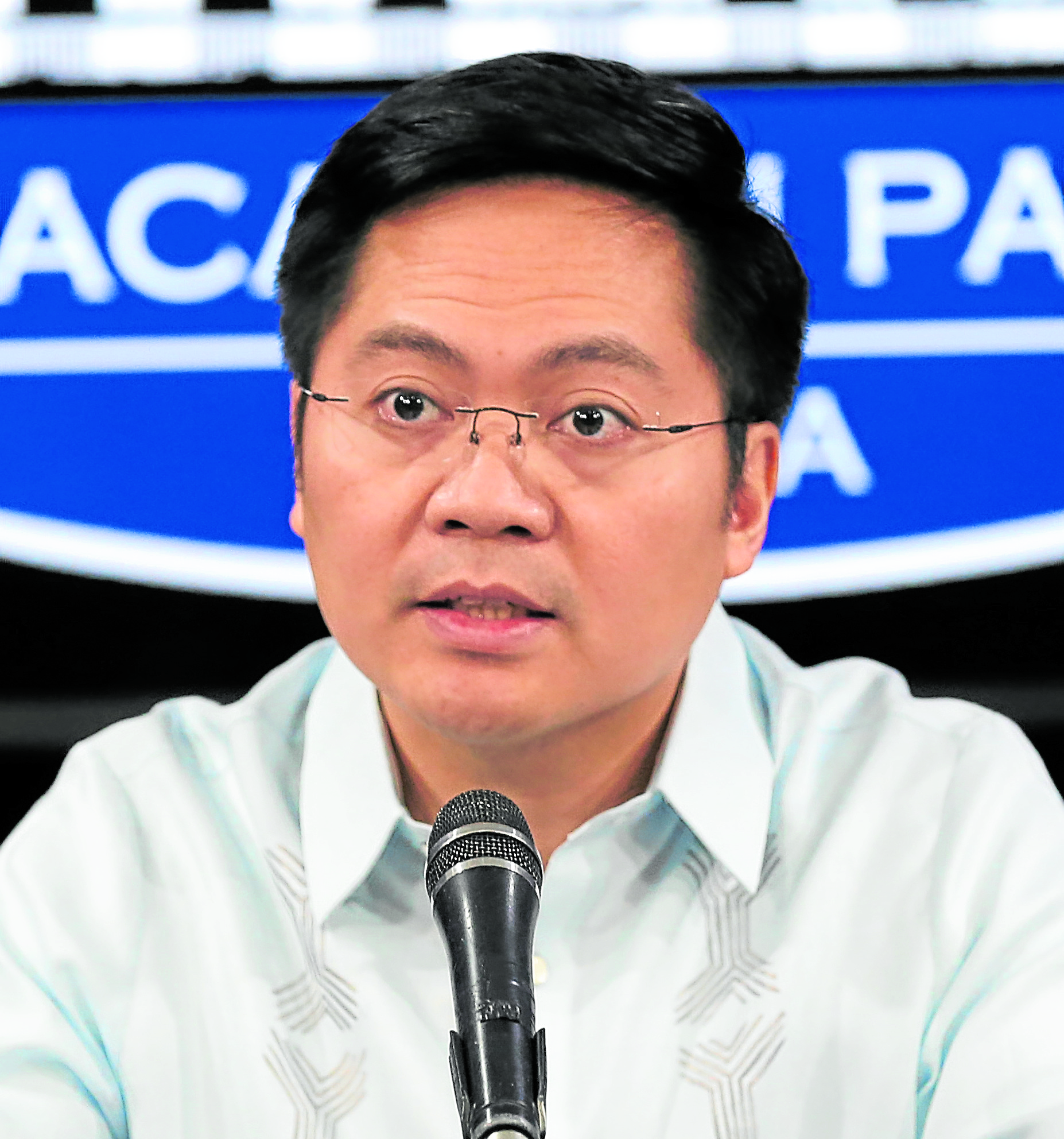
Cabinet Secretary Karlo Nograles during the Laging Handa press briefing on the update of COVID 19. INQUIRER FILE PHOTO
The government’s pandemic task force has shortened the period of isolation or quarantine for fully vaccinated healthcare workers infected with the coronavirus and those exposed to COVID-19 patients so that they could return to work sooner and prevent hospitals from being understaffed.
“If they are quarantined and isolated for a lengthy period, we don’t want us to run out of health-care workers who would man our hospitals and health-care facilities,” acting presidential spokesperson Karlo Nograles said during a meeting at Malacañang on Thursday night.
The Inter-Agency Task Force for the Management of Emerging Infectious Diseases (IATF) also allowed home isolation and quarantine for patients who are asymptomatic or have mild to moderate symptoms, as well as their close contacts, according to Nograles, who is also the Cabinet secretary and cochair of the IATF.
Infectious disease expert Dr. Marissa Alejandria said guidelines would be given to the public on the home management of vaccinated COVID-19 patients with mild symptoms.
Home care would free up hospital space for severe and critical patients, and non-COVID-19 cases requiring hospitalization, Alejandria said.
The modification of the isolation and quarantine rules follows a week of what President Duterte had described as “galloping” cases of COVID-19, which the Department of Health attribute mostly to the Delta variant.
Health Undersecretary Maria Rosario Vergeire said hospital infection prevention and control committees and provincial health offices were authorized to implement a shorter five-day isolation period for COVID-19 positive, fully vaccinated health-care workers who are asymptomatic or have mild to moderate symptoms.
Fully vaccinated health-care workers who are close contacts of COVID-19 patients may no longer undergo quarantine, she added.
Vergeire said, however, that these hospital committees would have to make a thorough study before implementing these protocols, which would depend on the needs of the facility and the risks and benefits.
She said the new isolation and quarantine period for fully vaccinated health-care workers was now shorter than the requirement for the general public, which would still be 10 days of isolation for those positive for COVID-19 and seven days for their close contacts.
Space requirements
Home quarantine and isolation are allowed for COVID-19 positive patients as long as they have their own rooms and bathrooms, and could be monitored by the local government or health-care provider, otherwise, they have to be transferred to an accredited isolation facility to avoid infecting the rest of their households, Vergeire said.
She said household members of these patients could be considered close contacts.
Members of such households may undergo home quarantine together if they have no symptoms, are not senior citizens or persons with comorbidities, and would not be exposed to other COVID-19 patients, Vergeire said.
Officials also said that the growing number of health-care workers who could not help administer vaccine shots after contracting COVID-19 also caused a slowdown in the vaccination drive.
Storm blamedHealth Undersecretary Myrna Cabotaje told Friday’s Laging Handa briefing that Typhoon Odette (international name: Rai) also contributed to the slower pace of inoculations after some 21,000 vaccine doses in Iloilo, Central Visayas and the Caraga region were destroyed by the storm.
The Philippines has received 210 million doses of the COVID-19 vaccine and has fully vaccinated 51.66 million individuals as of Jan. 6. Booster shots were administered to 2.8 million.
Facilities full
Vergeire said the infection had also been spreading to many of the staff of the laboratories testing for COVID-19 and this was causing a delay in the release of test results, leading to late reports of new cases.
With such delays, she reminded people waiting for their test results to isolate themselves if they were experiencing symptoms or had been exposed to a COVID-19 patient. This would help cut down transmissions if they eventually turn out positive for the virus, Vergeire said.
The Bureau of Quarantine (BOQ) is also reporting that quarantine facilities for returning overseas Filipinos (ROFs) are now full and that dozens of its personnel have also caught the virus.
Around 3,500 to 4,000 ROFs arrive daily and although most of them are vaccinated around 80 to 100 are testing positive, according to BOQ Deputy Director Roberto Salvador Jr.
“Right now, we do not know where to bring them because the quarantine facilities allotted for them are already full,” he said in a radio interview on Friday.
“We only have very few cases of unvaccinated ROFs. But even those vaccinated and with negative RT-PCR (reverse transcription-polymerase chain reaction tests), many of them have tested positive for COVID-19,” Salvador said.
ROFs with vaccination cards and negative RT-PCR test results will only have to complete a five-day quarantine, but those without these requirements will have to be quarantined for seven days, he said.
Salvador disclosed that he and around 60 other BOQ personnel had tested positive for COVID-19.
“We are calling on the government to respond to the needs of the BOQ. We lack personnel,” he said.
Salvador said that he was in quarantine but still performing his tasks as he seemed to be recovering from symptoms, such as high fever, colds and cough.
Nograles said the IATF was looking into possibly including the number of available health-care workers as another factor in determining the alert level for a particular area. Among the indicators that the task force takes into account is the health-care utilization rate, specifically the number of hospital beds and ventilators in use for COVID-19 patients.”
“As the experts have said, and based on the experience on the ground, many of our health-care workers are under quarantine because they were exposed to COVID-positive cases, while some have mild COVID and are isolated. So we have to look at the health-care workers as another indicator when we decide on alert levels,” Nograles said. —WITH A REPORT FROM TINA G. SANTOS